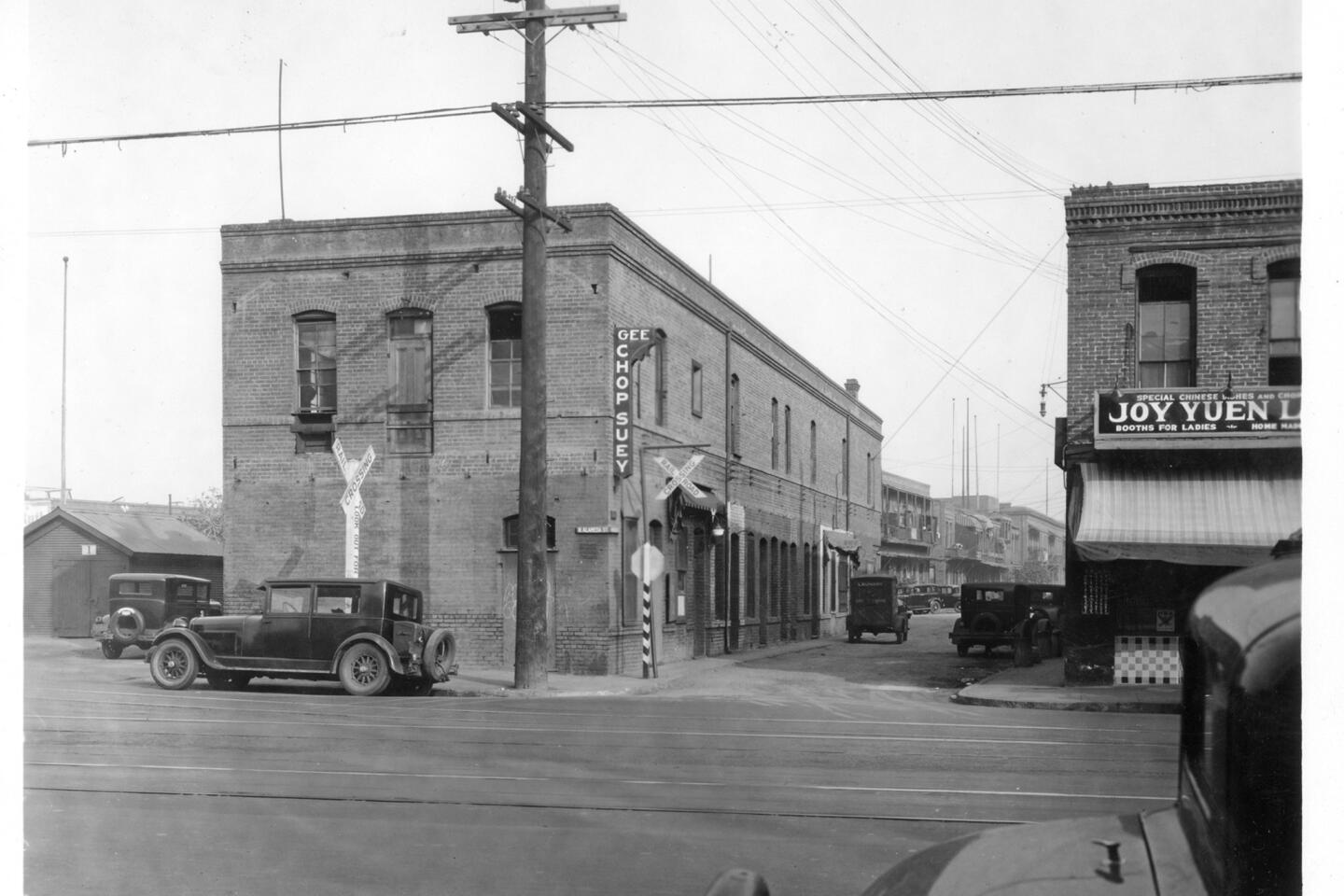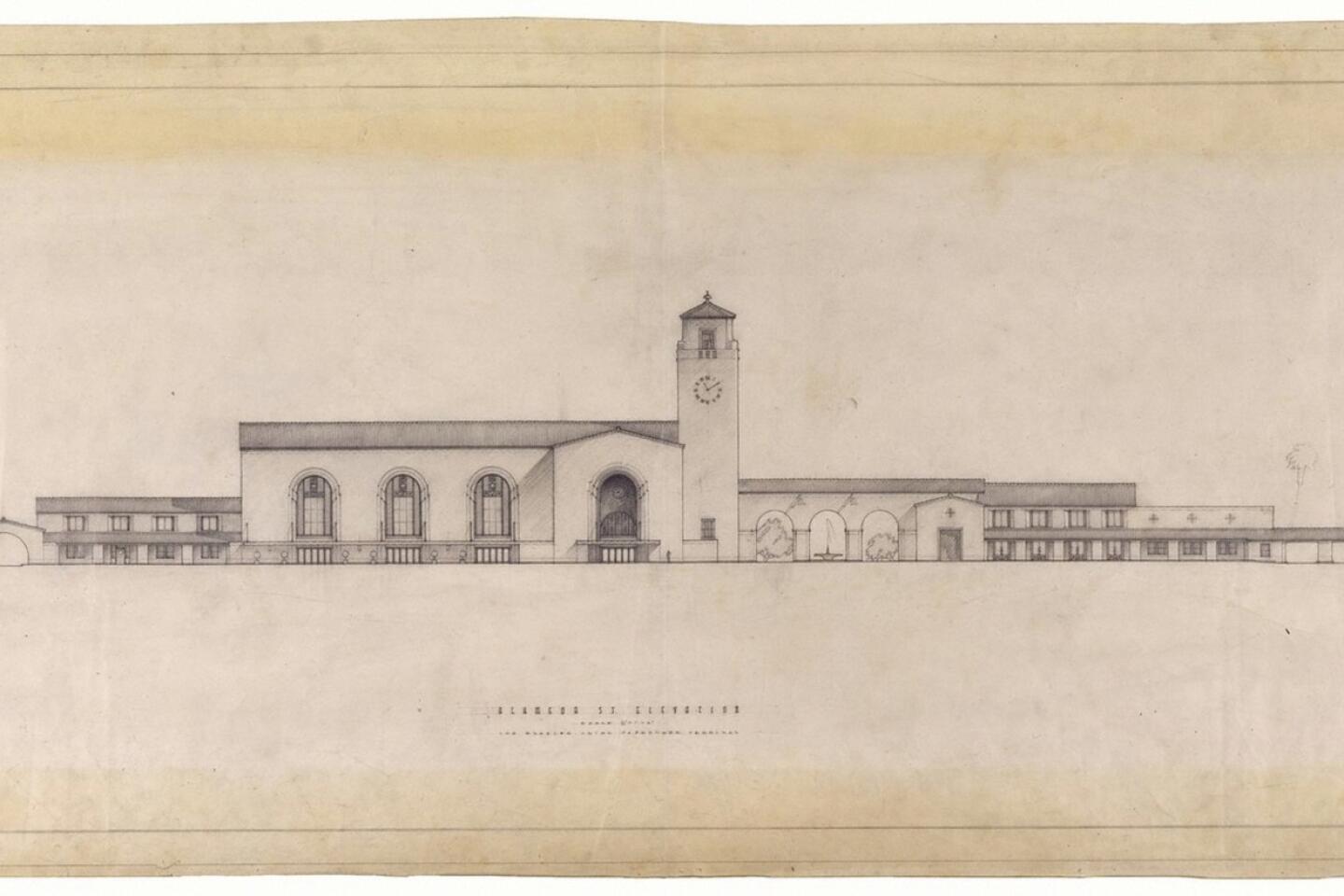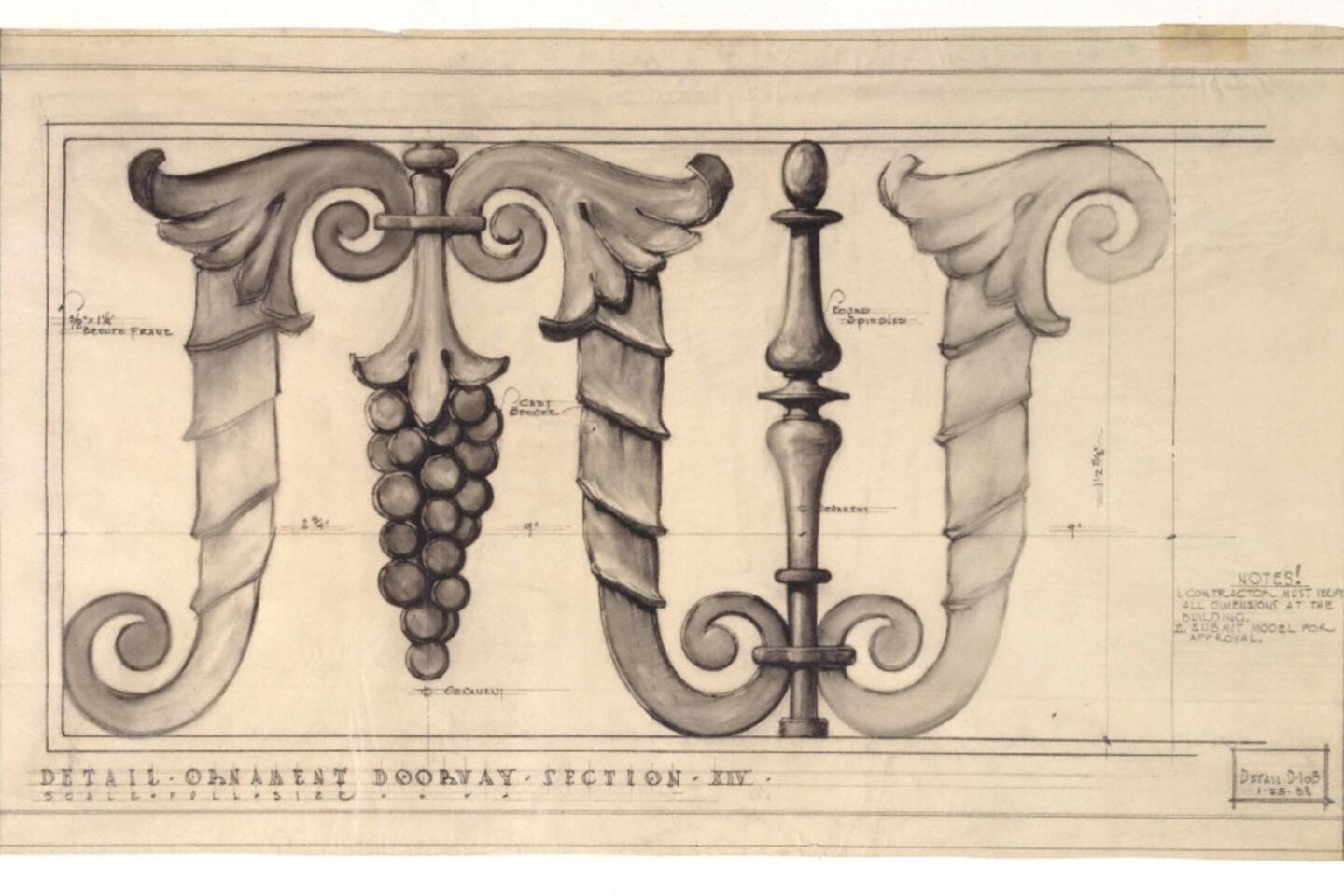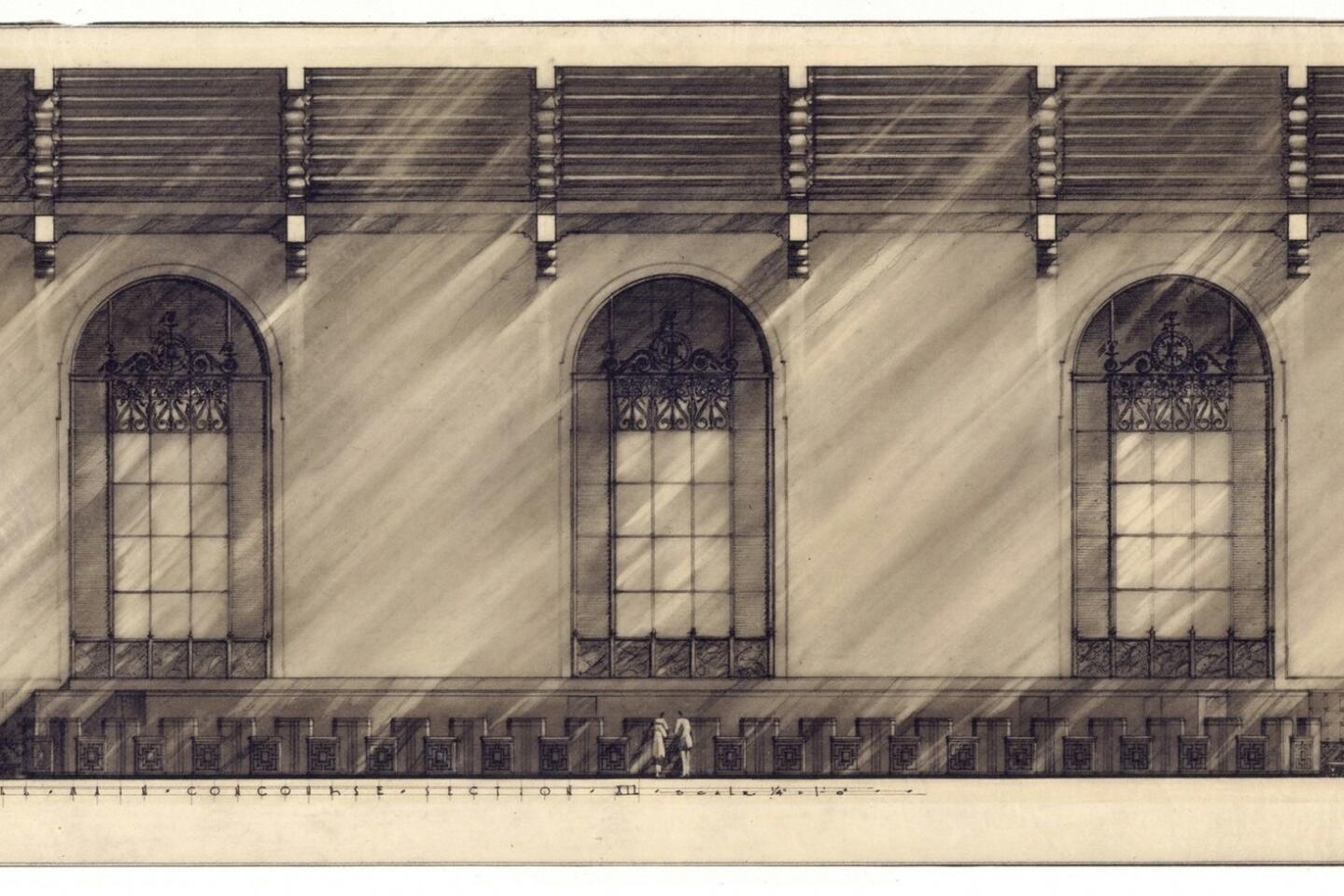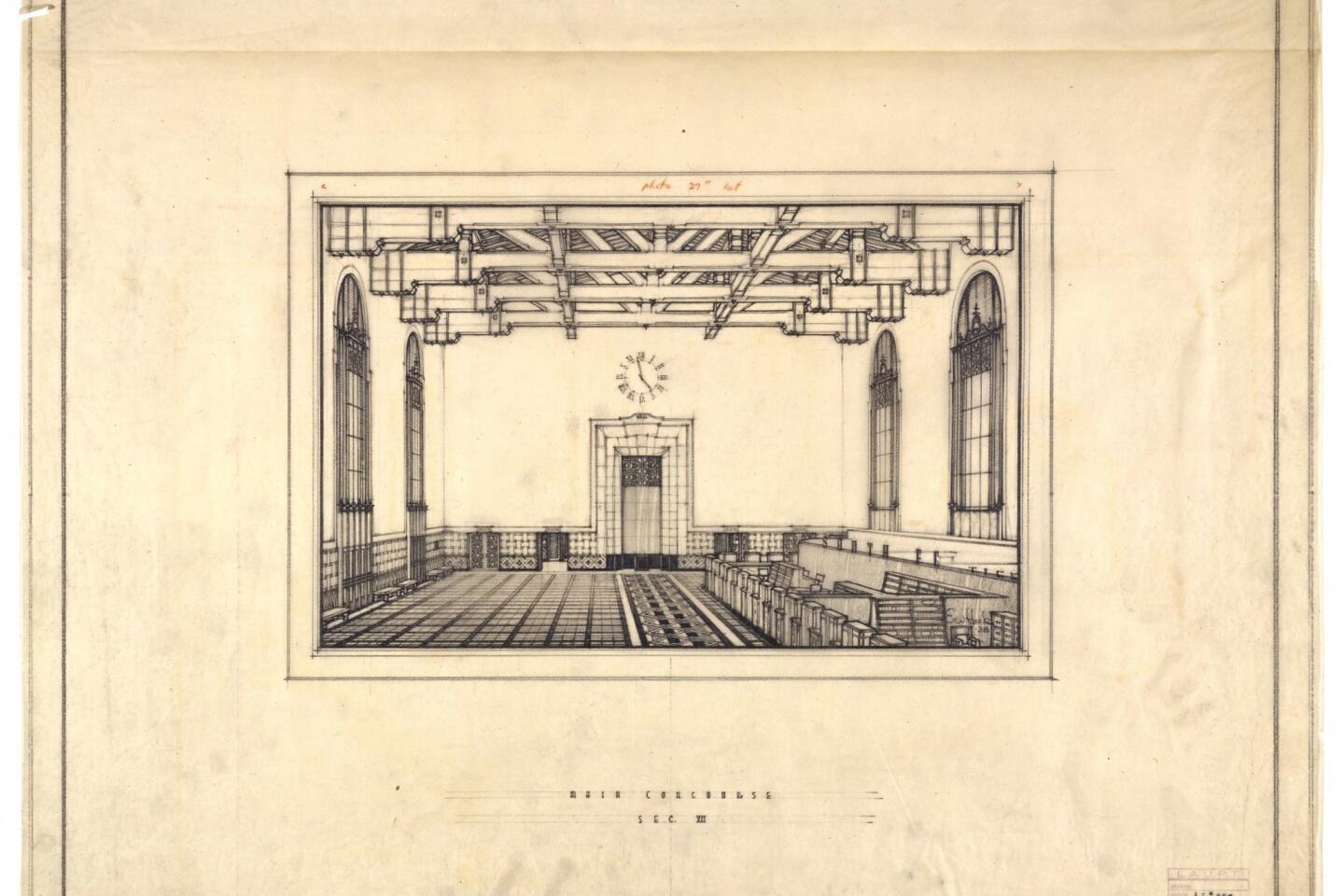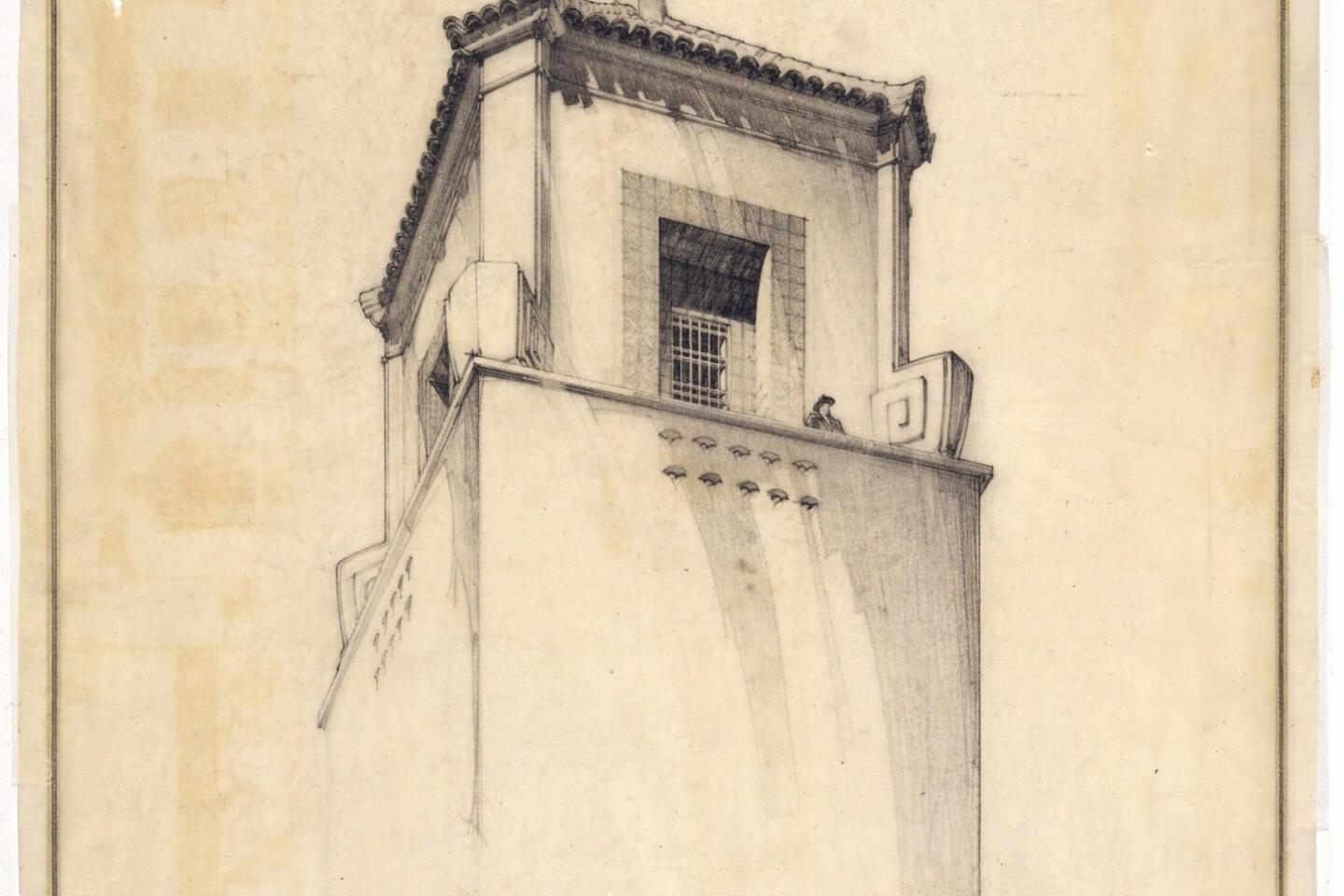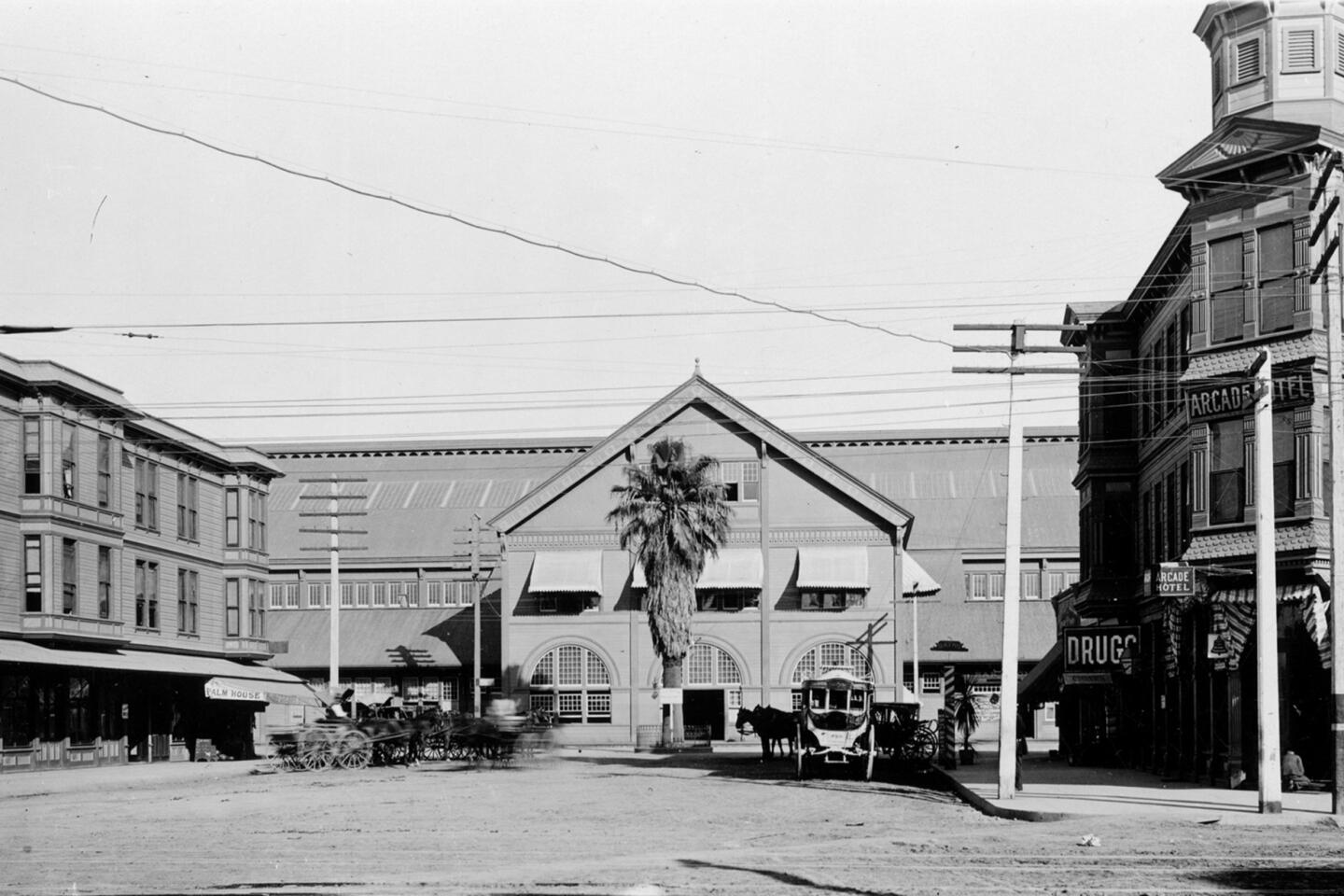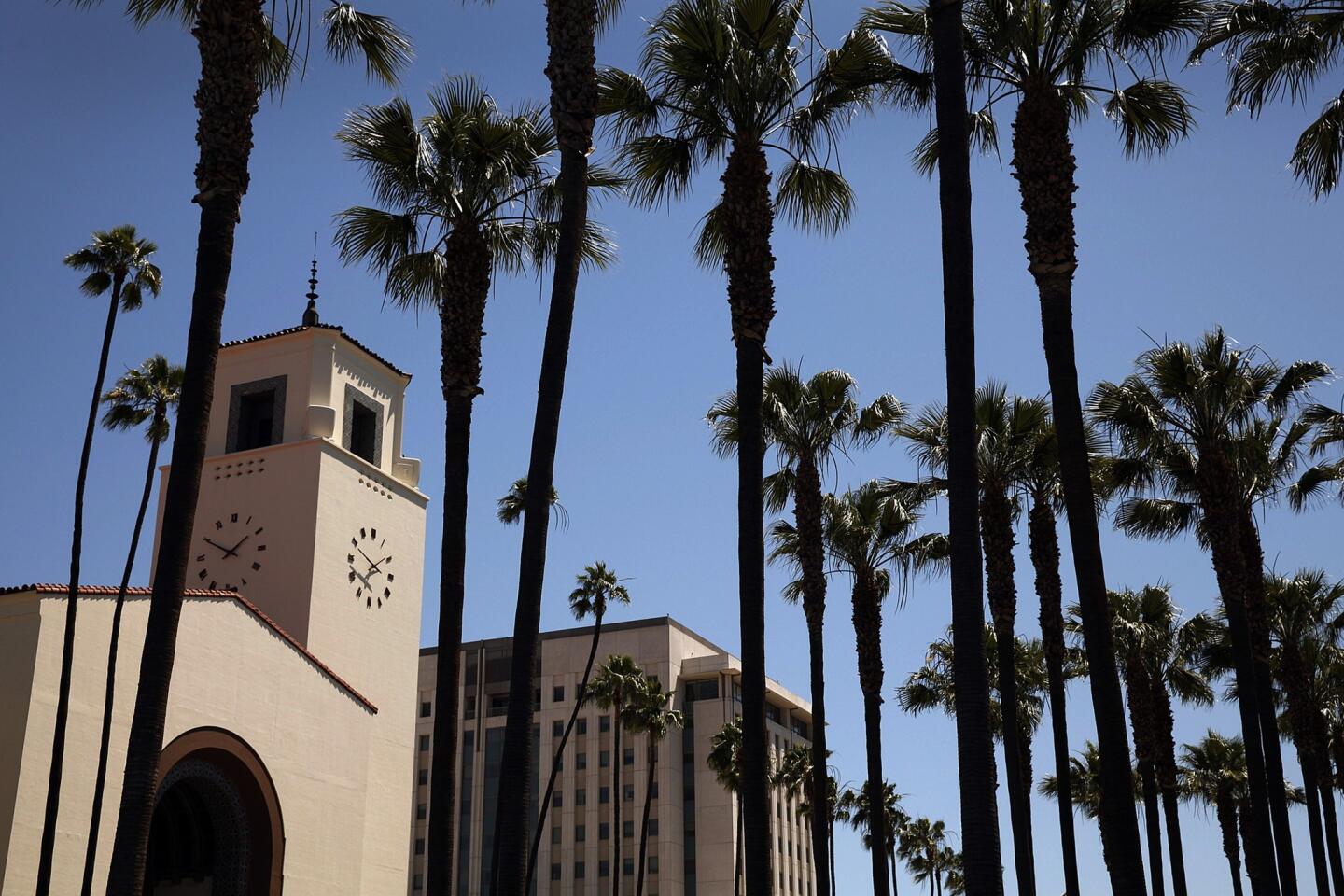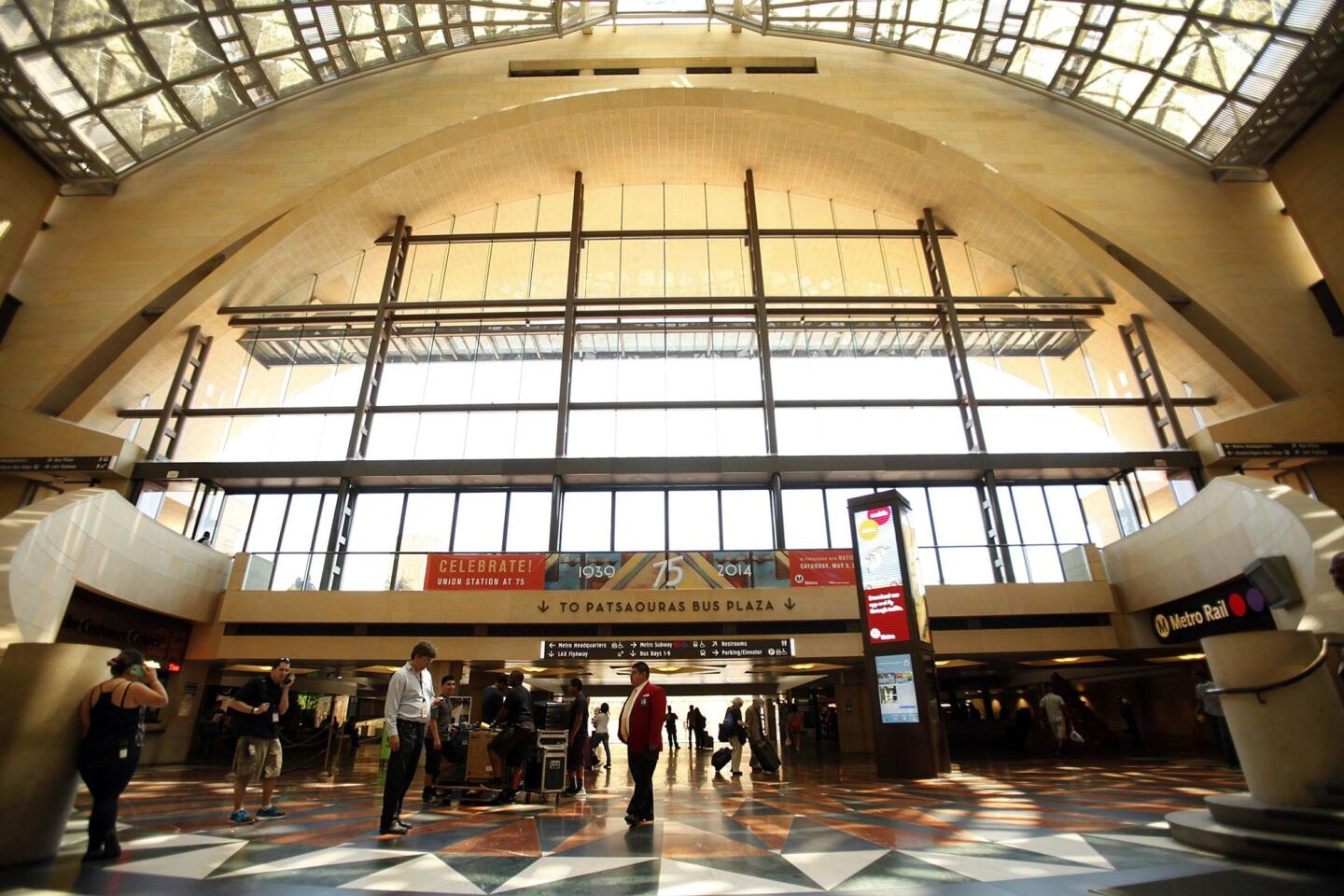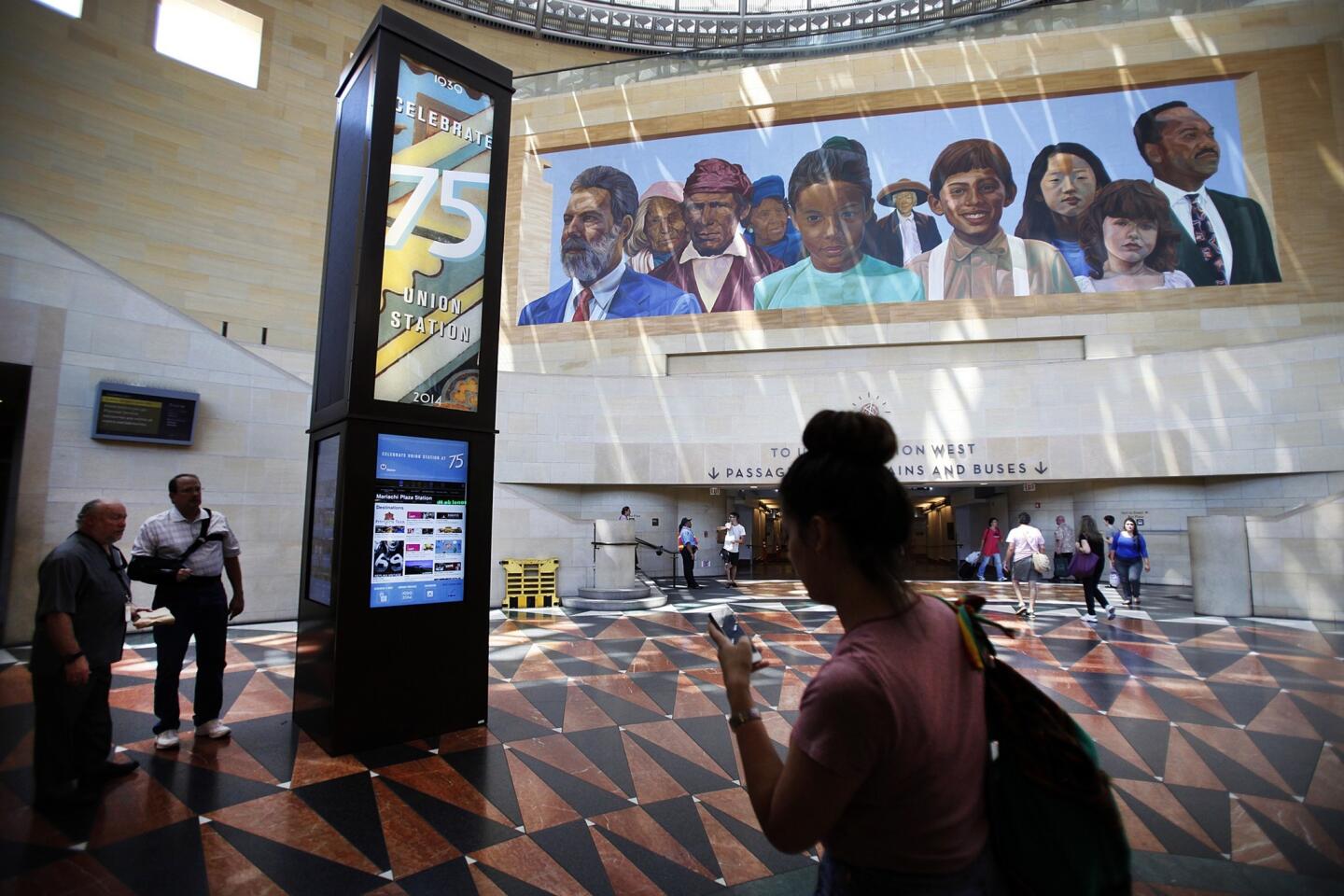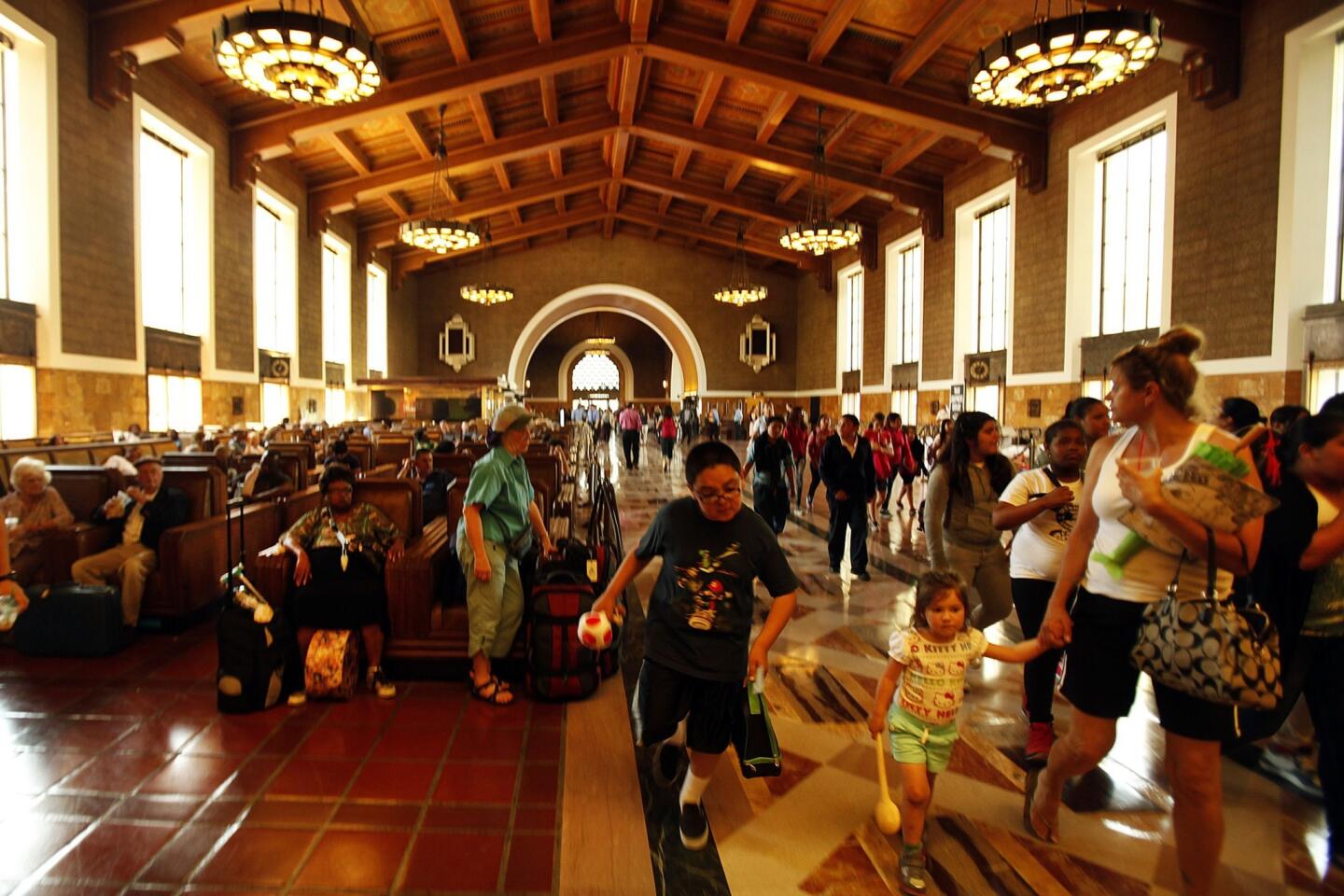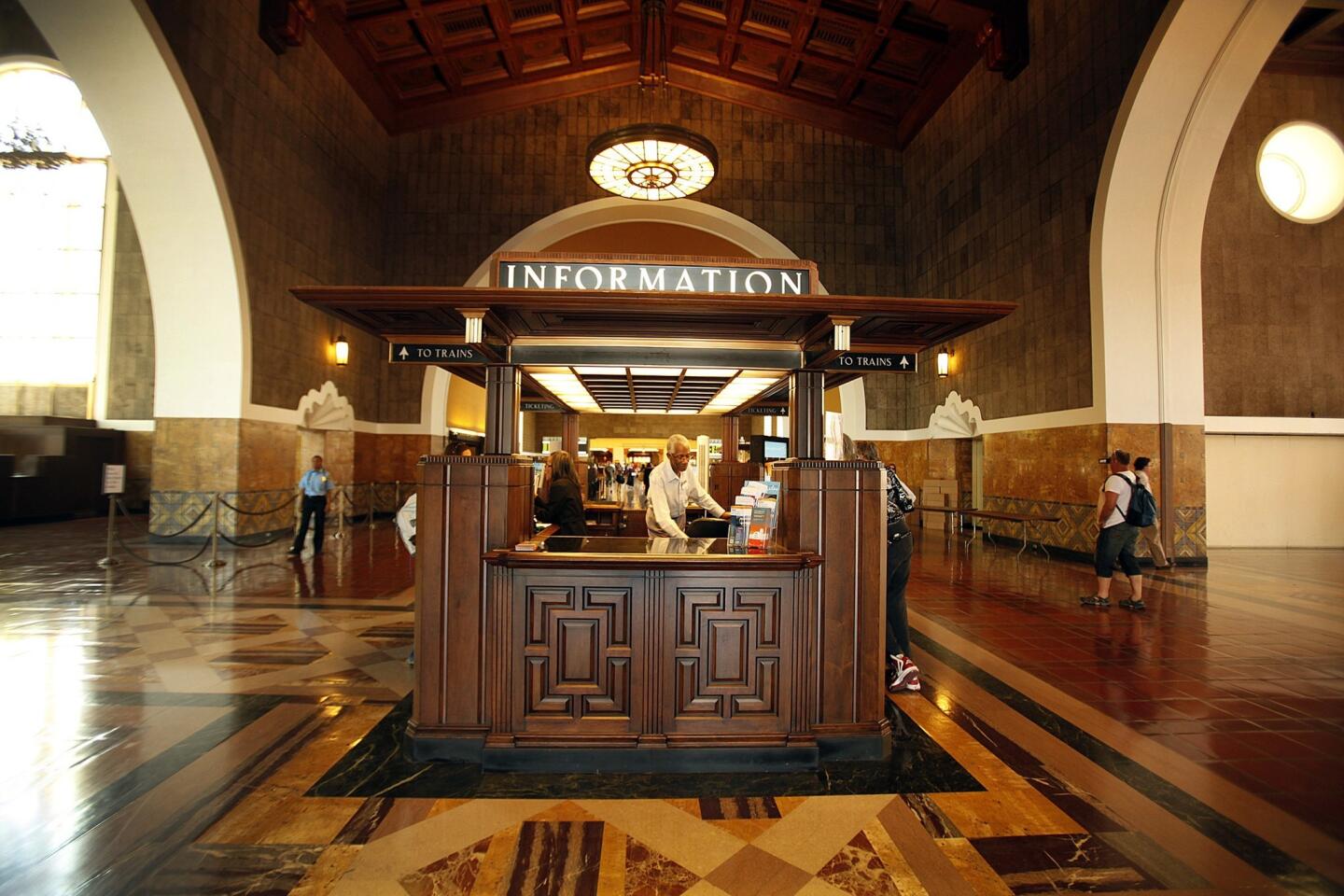Critic’s Notebook: Union Station’s complexity grows 75 years down the line
- Share via
The remarkable vintage photographs of Union Station’s opening in 1939 show the streets and sidewalks around the new building packed with a huge and expectant crowd. Those of the interior reveal a vast, high-ceilinged waiting room, with impeccably dressed passengers sitting not on hard wooden benches but in individually upholstered lounge chairs.
Do not be fooled by these pictures. While it is easy to think that they depict some Golden Age of rail travel in Los Angeles, the truth is that the Golden Age of rail travel in Los Angeles is just getting underway.
In the decade after Union Station opened in 1939, it handled about 13,000 rail travelers a day. Today that number is roughly 75,000.
It will keep climbing in the next few years as the Metropolitan Transportation Authority, which bought Union Station in 2011, expands the subway and light-rail network in L.A. County and remakes the station and the surrounding area under a new master plan. And the figure will jump again if high-speed trains begin running between San Francisco and Los Angeles.
Union Station, designed by the prolific John Parkinson and his son, Donald, in a retrograde but winning blend of Spanish Colonial Revival, Mediterranean, Moorish and Art Deco styles, wasn’t advertising the importance of rail to 20th-century Los Angeles when it opened as much as mourning it. It was clear by that point that the private car and air travel represented the future.
What the giant crowds were celebrating, as much as anything, was the fact that the richly appointed piece of civic architecture, caught for nearly two decades in legal battles between the city and the railroads that twice reached the U.S. Supreme Court, was finally finished. Had the delays stretched another year or two, into the teeth of the Second World War, it’s possible that construction might have been put off indefinitely.
The story of Union Station, which marks its 75th anniversary on Saturday, is that kind of story: Contradictory, surprising, far more layered than most Southern Californians realize.
There are certainly buildings in Los Angeles more imposing or innovative, and there may be a handful more beautiful. But it’s hard to think of another landmark that has played such a pivotal role in so many aspects of the city’s growth and evolving self-image.
Imagined as early as 1909 as a way to unify the operations of the three dominant rail companies in Southern California (hence its name), the station was a major civic monument that was also paid for largely with private railroad money.
And though the details of its interior look as impressive today as they did when the station was new, the building was constructed by executives whose desire to build a shrine to the glories of rail travel and of Southern California itself was tempered by a steadfast attention to the bottom line.
Cincinnati’s 1933 Union Terminal, a grand exercise in Art Deco architecture, cost $41 million. Union Station, finished six years later, cost $11 million.
Its architecture, spare and Spanish on the outside and ornate and eclectic on the inside, draped the building in nostalgia for some mythic pre-modern Los Angeles. It borrowed details from a wide range of earlier landmarks, including the Santa Barbara County Courthouse and Riverside’s Mission Inn.
As a piece of urban design, however, Union Station was ruthlessly modern, a powerful engine for an urban-renewal plan that displaced hundreds of residents of L.A.’s original Chinatown and served as a precursor to later “slum clearance” efforts in Chavez Ravine and on Bunker Hill. In facing almost due west, the station not only announced the end of the line for American territorial expansion but helped the city turn its back on the Los Angeles River.
It didn’t seek to undermine the growing car culture. It actively supported it. The 200-foot gap between Alameda Street and the station’s front doors was a suburban distance, not an urban one, leaving plenty of room for parking.
More to the point, by going up when and where it did, Union Station influenced the location of key highway interchanges in and around downtown. As Matthew W. Roth writes in “Los Angeles Union Station,” a new book published by the Getty Research Institute, which has also organized an anniversary exhibition on the station at the Central Library, “the consolidation of track operations at Union Station set in motion the process of bridging the Los Angeles River with a freeway — and, in turn, the routing of the freeway network.”
The decision to put the building across Alameda from the historic Plaza, between City Hall and the river, “exerted gravitational force on the layout” of the freeways, Roth writes. The choice of site “pulled the Santa Ana Parkway to the east and the Hollywood Parkway to the north and thereby set the locations of other nodal structures, including the Four-Level Interchange and the San Bernardino Split.”
Those facts, he argues, “should give pause to accounts of the city’s transportation history framed primarily as a contest between road and rail.”
After the war the city began building its public monuments almost exclusively in the modern style, their flat roofs stripped of red tile. Union Station, this last gasp of revivalism, was different not just in form but in sensibility. It was a final tribute to the collective — to the romance of the crowd — in a city that would spend the rest of the century, in architecture as in planning policy, celebrating the private individual.
Still, this was no clanging, overcrowded train shed. As William Bradley points out in another book marking the building’s 75th birthday, “Los Angeles Union Station: Tracks to the Future,” the architects were keenly interested in avoiding “the hubbub normally associated with train stations.”
The clock tower has never sounded: It was built without chimes. No billboards were allowed on the property, streetcars were pushed to either end of the station and utilities were hidden underground.
In the air-conditioned interior, the team of architects (led by Donald Parkinson after 1935, when his father died) pushed the ticket booths and the telegraph office far from the waiting room, to keep the ambience surrounding those lounge chairs as tranquil and civilized as possible.
Union Station has been newly polished and touched up in advance of this weekend’s milestone by the Pasadena firm Architectural Resources Group. Though there is still room for improvement — the recent decision to cordon off chairs for ticketed Amtrak passengers only is a significant blow to the station’s role as a civic space — on the whole it is looking better under Metro’s ownership than it has in many years.
If Metro can find the right tenant for the stunning but long-vacant Fred Harvey restaurant, the revival of downtown will have officially jumped the 101 Freeway and reached Union Station.
Just after the building opened in the spring of 1939, the design journal Pencil Points, a reliable supporter of modernist architecture, published a short essay by a correspondent in Los Angeles, Paul Hunter. He didn’t waste time stating the obvious: That the station looked old-fashioned, out of step, to many local architects.
“As far back as the late Twenties, Spanish was no longer considered a smart architectural style, and it is not used much any more even by the speculative builders,” he wrote. “When it was generally learned that the railroads had voted to clothe the steel frame in Spanish dress, the more progressive members of the profession threw up their hands.”
The significance of the station lay not in architectural decoration or symbolism but in the way it reshaped a huge section of downtown Los Angeles and consolidated a set of ambitious ideas about how the city as a whole ought to grow. Then as now, its nostalgic architecture was merely a mask.
-----------------------------------------
Union Station at 75
Where: Union Station, 800 N Alameda St., Los Angeles
When: 10 a.m.-4 p.m. Saturday
What: Self-guided tours, model trains, exhibits, live entertainment. Free train rides to Glendale and back for first 500 people per hour.
Contact: https://www.metrolinktrains.com
More to Read
The biggest entertainment stories
Get our big stories about Hollywood, film, television, music, arts, culture and more right in your inbox as soon as they publish.
You may occasionally receive promotional content from the Los Angeles Times.
